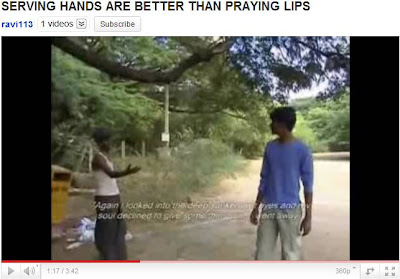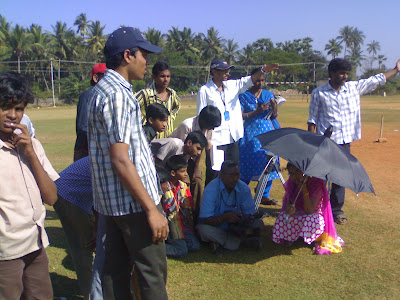After writing few short-stories and screenplays in under-graduation and graduation days, I decided to start filming a small project – but how, I had no idea. Hari Shankar is my college mate who is interested in films and made a few short films. I heard really cool things about his films and his filming style from his friends.
It was the Annual day celebrations of our college in March 2007: It was one of the life-changing days of my life… Hari was making arrangements to screen his short film ‘SERVING HANDS ARE BETTER THAN PRAYING LIPS’ for which he won the second place at IIT (Madras) Saarang Short Film Festival. I was one of the anchors for the celebrations; after I did my part, I came down and sat a little away from the side screen where the short film began to play. How often do you get a chance to see a film which is made by the person whom you see regularly? Not quite.
The short film was for just few minutes. Although it was made only in few hours, I could see various camera angles, depth of characterization, dream-logic, emotion, hear good music and most importantly, it made many think for a while that ‘serving hands are better than praying lips’. I never knew that there is so much hidden talent in Hari; it was something I could not see in most of the recent Indian film-makers.
There is one particular shot – where the young man sees a beggar (whom he had earlier seen in his dream); I particularly liked the way the camera shows only the reaction of the young man and then it pans slowly revealing the beggar whom he saw in his dream, and then it goes back to fully reveal the dream sequence which happens in reality to the young man. I was so much impressed with that shot that at that instant; I decided to work with Hari to make a film.

A snapshot from his short film
After both of us got selected to a Multi National Company through Campus Interviews, I called up Hari and told of my plans of making a movie together. He came down to an ice-cream parlour near my home, Frosty Ice Cream parlour, which is the place where I started many interesting things in my graduation. He told me about how he was inspired by movies, how much passion and liking he has towards making films. His understanding and analysis of movies is far beyond his age… He was like a book of world cinema to me! Even today, I see movies suggested by him and wonder how he could capture the intent of any film’s director at such a young age. From that meeting onwards, he is like a mini Ram Gopal Varma for me!
Even I discussed my stories with Hari; and he liked the originality and imagination that goes into writing them. I briefly narrated him one of my stories (the working title was ‘Eesa Qyun?’ – a horror, suspense drama based on a love story); even he was impressed by the way the story was structured, how the characters were designed, and how the suspense was carried and built all through the story. It was not like the usual horror movies which we generally see these days. Even today, I consider the suspense scenes in that script as the best scenes I have ever written – they are very original and very intriguing. I used shadows and curtains and many delicate materials like heroine’s dupatta, her hair in a very innovative way to drive the suspense in the story. Hari was very very impressed with that story – he could see how well I could make the viewers involve in the story. Anyways, that film (EQ) will be made after many years.
We never had any guides or gurus, we just happened like what we are through self-learning, observation and analysis. Artists are born out of nowhere you know!
Now that we came to know about our latent talents, I put a proposal that we will make two films – one film which will be directed by Hari and written by me, and the other film it will be otherwise. (That idea was inspired by an article in the Hindu Newspaper where I read that Steven Spielberg and Peter Jackson are sharing director/producer roles for ‘The Tintin Trilogy’). Hari agreed for that, saying that the first will be directed by me and written by Hari.
He told me four stories; all four of them were very good. I wanted a story which could be told with minimal usage of sets, minimal usage of cranes and dollies for the camera setup; and also, I wanted something which people of our age could relate to. So I chose the story about two friends who share a very special bond, get separated due to unknown reasons, and how they re-unite or not forms the rest of the story. He tentatively titled it as ‘Caste Away’, as it deals with the still prevalent caste biases in colleges and families. I thought it has a strong social message that all men are equal, and which is told through a very simple story of two good friends. In a fraction of second, I said to him that this is going to be my film.
It was actually decided to be a short film (of about 10-15 mins), but as I started visualizing the story, I started getting beautiful ideas and I developed it my own style (with the permission of Hari) and the outline was ready for the film with an estimated running time of about 100 minutes.
From the fundamental story which Hari gave, characters started coming up, events started transpiring; scenes, sequences, and then the final story was ready in my mind – well, about 60% of what you can see now was in my mind by then. Hari came to my home this time and I narrated him the developed story. He initially had doubts whether such a project of large scale can be pulled off or not; I simply said ‘yes, I can do it’. By that time, I had already met Satish Anna and discussed with him about the project. It was quite natural for him to express doubt because I never had any experience in films or film-making, and making a movie out of a complex story structure will be very tough. Rabi Kisku of IIT Madras could make a 75 minute feature film ‘Silicon Jungle’ without much filmmaking experience. If some Indian engineering student could do it, why can’t I do it? That was my gut feeling, which convinced Hari give to give the green signal.
After reading the first draft of the screenplay Hari was very happy with the way it came out. He was convinced that the story was neatly made into a screenplay with more characters, events and situations.
Hari gave advice to me during the development of the film, like how to shoot various actors, locations; how the lighting should be set up; and how the camera should move. I had basic ideas of all those things, still I listened to him patiently and improvised them. Even today, I consult him on how to execute a good idea – after all, he is my first Guru in films whom I could meet in person and take advice or suggestions.
.jpg)
The exterior cricket scene was directed by Hari and co-directed by me. In the above pic, Hari (standing, extreme right) and I are asking some player to move to a different location to be captured by the camera. I think we are thinking in sync during those moments; both of us are in similar positions in the pic J
I actually wanted Hari to direct the church scene where I act in a small role. Due to some problems, the shoot in the church was postponed, and we managed to shoot the cricket scene that afternoon. I particularly wanted Hari to direct the scene where I act – I thought that would be a great idea - a director directing another director! During the actual shooting of the church scene, he was busy with an exam and I had to do the direction myself. I think this will be a wish left from me which should be fulfilled in some of my later works.
After watching the rough cut of the movie, we sat and discussed about the music of the film. In fact it was Hari who referred Guru Prakash’s name to me, and Guru later became the film’s music composer. He said that there is a hidden genius in Guru who can compose tunes just as you like. We decided upon few themes songs (using various instruments), and a few recurring tunes which suit the various emotions in the story. Even after the final cut of the movie was over, he gave me suggestions over where to do the brightness, colour and saturation corrections. I used ideas given by Hari (in almost all departments of film-making) as cues and worked as required.
All in all, he was there all through the development and making of the film. If I was able to convincingly make the film so well, it was all because of the knowledge, guidance, inspiration and enlightenment given by the originator of Special Friend film: Hari Shankar Naidu!
-----------------------------------------------------------------------------------
P.S. 1: When Hari and I went to meet Rabi Kisku at his home in Bangalore, Hari went through the collection of movies at Kisku’s TV and started talking about old Hollywood classics and how much they influenced world cinema. Kisku was surprised how he knew all these things without any formal training in films. My personal belief is that Hari is an uncut and unpolished gem; with proper cutting and polishing, he will surely reach great heights in his life! He is now cutting and polishing his talents to show the world the real gem in him… Watch out for more about him in the future.
P.S. 2: The plans for the second film, as per the proposal, are not yet concrete – but it will be made someday. Our friendly relationship and discussion about movies and movie-making continue even till day. After all, I hope that our combination will stay remarkable in the field we would like to enter in the future.
P.S. 3: I am posting here two of the short films made by Hari few years ago. Mark the sensibility, voice of film, taking, music and visuals captured in the shorts.
Serving Hands are better than Praying Lips
http://www.youtube.com/watch?v=LOa-XI41b44
Celebrating Diversity
http://www.youtube.com/watch?v=Qc4OtV0IHNs

.jpg)

















.jpg)


































